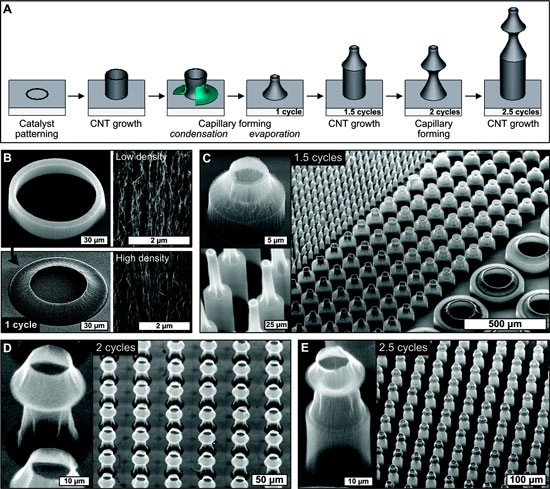| Dec 16, 2011 |
Novel method for fabricating corrugated 3D carbon nanotube microstructures
|
|
(Nanowerk News) Researchers from imec and the University of Michigan present a method that for the first time allows the stacking of sequentially folded CNT micro-architectures (paper in ACS Nano: "Corrugated Carbon Nanotube Microstructures with Geometrically Tunable Compliance"). Arrays of such structures with a great variety of lateral dimensions (i.e., from < 10µm to >100 µm) can be fabricated in close proximity on the same substrate, thus enabling integration of heterogeneous architectures in a scalable way. The attractive properties of the CNTs suggest that the method will find several new applications. Examples are the development of new microsystems with novel functionalities, as well as engineered materials such as omniphobic surfaces and dry adhesives.
|
 |
| Fabrication of cylindrical CNT microbellows by iteration of growth and capillary forming: (A) schematic illustration of the iterative process; (B) SEM images of a cylindrical CNT microstructure before and after capillary forming (1 cycle), with close-up images emphasizing the densification of aligned CNTs; (C–E) SEM images of microstructures after consecutive growth, forming, and growth cycles, reaching 2.5 cycles in image E.
|
|
The process starts by lithographic patterning of a catalyst film on a Si wafer, followed by growth of vertically-aligned CNT microstructures by thermal CVD at atmospheric pressure. Next, the straight CNT microstructures are transformed into sloped shapes by condensation and subsequent evaporation of liquid on the surface, the so-called capillary forming step. These two process steps can then be iterated and finally result in 3D corrugated structures. Arrays of such structures with varying lateral dimensions can be fabricated as illustrated below. This study further focuses on the fabrication of (arrays of) CNT 'bellows' and CNT 'cantilevers'.
|
|
First, the utility of cylindrical CNT 'bellows' for use as vertical microsprings was investigated. It was found that the properties of the corrugated CNT microsprings can be tuned on the basis of their geometry alone. E.g., the compliance (which is the reciprocal of the stiffness) of the springs is inversely related to their wall thickness. Microspring arrays are used commercially in probecards for the testing of electronic devices. For this particular application, the availability of a method for making arrays of compliant springs with small footprint is an important step forward.
|
|
Secondly, the method was used to create cantilevers. Iteration of growth and forming of semicircular shapes creates intricate overhanging cantilevers with multiple folds. These structures can be packed in dense arrays and oriented in any direction. We anticipate that these structures will be useful in the design of surfaces with anisotropic wetting properties and directional adhesives, where the asymmetric geometry, nanoscale texture, mechanical compliance and strong van der Waals attraction of the CNTs could be advantageous.
|
|
Finally, this process enables cost effective fabrication of vertical CNT walls with a thickness below 300 nm, and aspect ratios exceeding 1:100.
|

